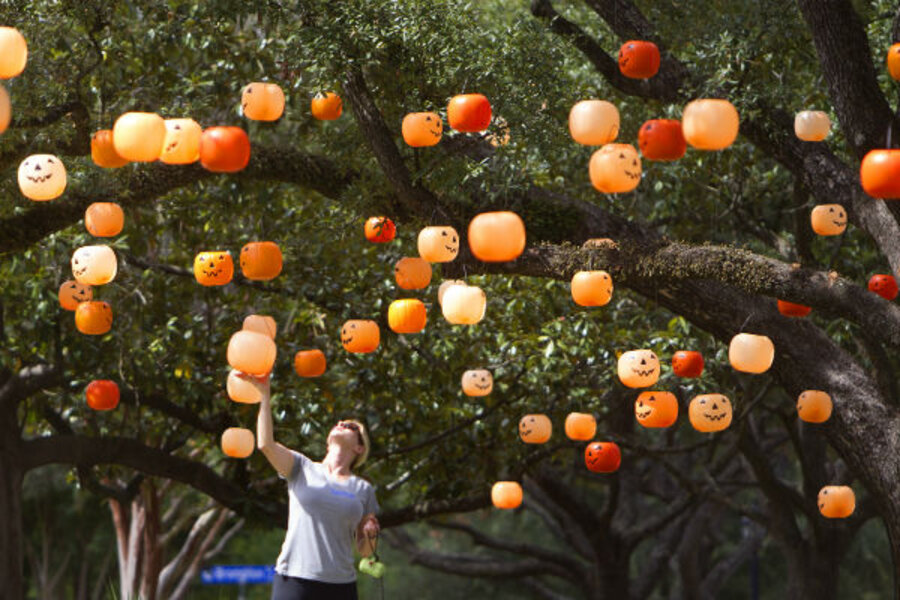Halloween 2014: Teal pumpkins, candy tricks, and other signs of the times
Loading...
Halloween is big business, worth $7.4 billion in annual spending in the United States. The National Retail Federation states that a record number of Americans are buying costumes in 2014.
Ten years ago, the average consumer spent $44.57 for a costume. Today, with 67.4 percent of Americans celebrating the holiday, the average spending per person is $77.52. As one of the fastest-growing consumer holidays, there’s more proof than ever that Americans love Halloween.
Some parents, especially those taking kids out for the first time, will notice that Halloween has changed in recent years. They may notice a few changes in the neighborhood, from the non-candy prizes to transformations in the actual act of trick-or-treating.
For starters, families are enjoying a non-traditional Halloween by “Trunk-or-Treating” and taking the treats to the backseat. Trunk-or-Treating has typically been a church or community sponsored event in a large parking lot that provides a safe and family-friendly environment. Participants decorate their vehicles for the festivities and open their trunks for children to come by and get candy. The decorations are typically not scary and appeal to preschoolers and toddlers.
Trunk-or-Treating is popular at schools, churches, and in rural areas where homes are too far apart, as well as in places where trick-or-treating is deemed unsafe. Look for Trunk-or-Treating announcements at your church, as well as through the local PTA and other neighborhood notices, or consider starting your own.
According to AlphaMom.com the trick to running a Trunk-or-treating event is to keep things simple. She suggests announcing the event and getting an estimate of the number of attendees. Keeping the event under an hour and asking each participant to bring one bag of candy are also useful suggestions for throwing a successful event.
Keeping kids safe on Halloween has always been a priority. This year, concerns have been raised in Denver over the possibilities of candy infused with marijuana being handed out to kids. The Denver Police Department recently released a public service announcement on its Facebook page alerting parents. According to The Christian Science Monitor, the pot laced candy looks almost identical to familiar favorites like Sour Patch Kids.
However, as mentioned in the PSA, those who choose to infuse candy with marijuana tend to use cheaper, generic candy brands. Police have warned parents to examine the candy to ensure that the wrappers are sealed and to throw away any generic or non-name-brand candies.
In some neighborhoods, non-food treats are making a bigger appearance this year because of The Teal Pumpkin Project, a new campaign from the Food Allergy Research and Education (FARE) organization. The campaign encourages families to place a teal pumpkin on their front step to alert trick-or-treaters that non-food treats are available at their home.
Promoting safety and inclusion for children diagnosed with food allergies is the main goal of the Teal Pumpkin Project while helping all children have a fun and positive Halloween. Debbie Strong of Allentown, New Jersey has a 6-year-old son who has been diagnosed with a few different food allergies. “It’s so hard to find treats that he can enjoy and Halloween the past few years has not been fun for him.” Ms. Strong goes on to say, “I am really excited about the Teal Pumpkin Project because he won’t feel like such an outcast this year. He will actually enjoy the treats he gets.”
Some parents, like Dawn Dropp of Philadelphia, PA, feel the amount of candy available for children is a bit much. “Between school parties and dozens of neighborhood houses, I feel like there is a candy overload. This year I purchased some inexpensive trinkets from the Oriental Trading Company to give away.” Ms. Dropp is not alone in her efforts to sweeten the neighborhood with novelties other than candy. Her neighbor, Jeanne Robbins, mother of a 5-year-old and 8-year-old said, “I’m giving out mini-coloring books and pretzels this year.”
For more non-food items to give this year try these 50 alternatives, or these other treat ideas.
Of course, Halloween treats don't mean a thing if there aren't visitors at the door to trick-or-treat. You’re sure to see characters inspired by the box office success of Disney’s “Frozen” show up on your front door, at least a few times. According to Amazon.com, the most purchased Halloween costume for girls this year is Elsa the Snow Queen, while the most popular costume for boys is Spider Man, which also hit theaters this year.
And despite the rise of “sexy” costumes – from firefighters to Olaf the snowman – parents can find thoughtful costumes they’ll love while also inspiring their kids to get creative.
While the new Halloween might not seem familiar for some parents, the biggest holdover from Halloween's of yore is the focus on fun for kids of all ages. With that sentiment still intact, the holiday, even with its modern updates, is still sure to be a treat.





